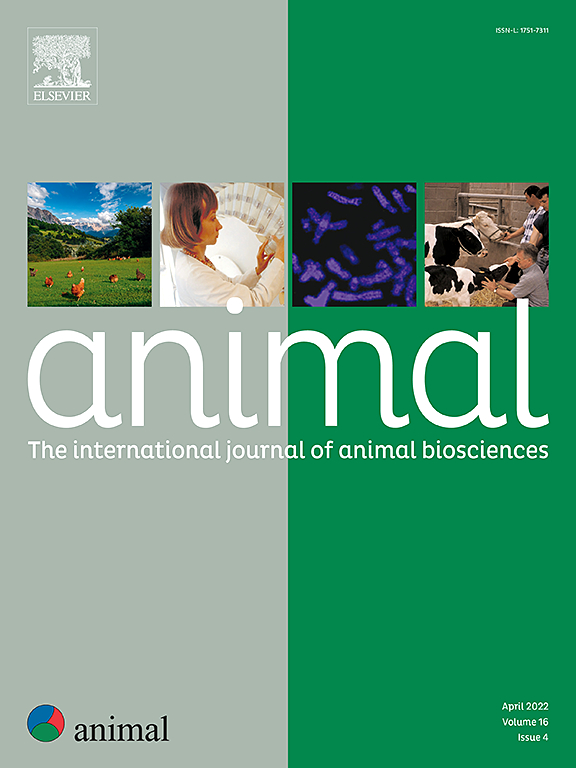选择特征的全基因组比较分析表明,候选基因可导致绵羊铜增殖的品种间差异。
IF 4
2区 农林科学
Q1 AGRICULTURE, DAIRY & ANIMAL SCIENCE
引用次数: 0
摘要
铜(Cu)中毒和缺乏问题继续影响着养羊业的经济收益和动物福利。本研究对绵羊基因组进行了调查,以寻找绵羊品种间铜增殖的选择区域和潜在基因。为此,我们比较了三个铜敏感品种和三个铜耐受品种的绵羊单核苷酸多态性(SNP)数据。在合并各品种的 SNP 数据并剔除相关个体后,共剩下 229 只绵羊和 45 640 个常染色体 SNP。然后,我们将每个品种选取 14 个个体分成两个数据集(数据集 1 和 2),使用固定指数法、跨种群扩展单体型同源性法和基于单体型的 FLK 法分析选择特征。通过至少两种方法检测到的两个数据集共有的选择区域显示,OAR 4、8 和 11 上的区域包含 54 个受铜增殖选择的候选基因。富集分析显示,19 个基因本体和 1 个富集的京都基因和基因组百科全书通路术语与受选择的候选基因相关。TP53、TNFSF13、TNFSF12、ALOX15、ALOX12、EIF5A 和 PREP 等基因与铜稳态调控、程序性细胞死亡或炎症反应有关。我们还发现花生四烯酸 15-脂氧合酶活性、花生四烯酸 12-脂氧合酶活性和铁蛋白沉积都对细胞炎症和细胞死亡有影响。这些结果揭示了绵羊基因组中铜富集的选择区域,并为进一步研究绵羊铜富集的品种差异提供了候选基因信息。本文章由计算机程序翻译,如有差异,请以英文原文为准。
Genome-wide comparative analyses for selection signatures indicate candidate genes for between-breed variability in copper accretion in sheep
The problem of copper (Cu) intoxication and deficiency continues to impact economic gains and animal welfare in sheep husbandry. This study investigated the ovine genome for regions and potential genes under selection for Cu accretion between sheep breeds. For this, we compared ovine single nucleotide polymorphism (SNP) data of three Cu-susceptible breeds with three Cu-tolerant breeds. After merging SNP data of breeds and removal of related individuals, a total of 229 sheep and 45 640 autosomal SNPs were left. Then, we selected 14 individuals per breed into two datasets (datasets 1 and 2) for analysis of selection signatures using the Fixation index, cross-population extended haplotype homozygosity and haplotype-based FLK methods. Selection regions shared by both datasets detected by at least two methods revealed regions on OAR 4, 8 and 11 containing 54 candidate genes under selection for Cu accretion. Enrichment analysis revealed that 19 gene ontologies and 1 enriched Kyoto encyclopaedia of genes and genomes pathway terms were associated with the candidate genes under selection. Genes such as TP53, TNFSF13, TNFSF12, ALOX15, ALOX12, EIF5A and PREP are associated with the regulation of Cu homeostasis, programmed cell death or inflammatory response. We also found an enrichment of arachidonate 15-lipoxygenase activity, arachidonate 12-lipoxygenase activity and ferroptosis that influence cellular inflammation and cell death. These results shed light on ovine genomic regions under selection for Cu accretion and provide information on candidate genes for further studies on breed differences in ovine Cu accretion.
求助全文
通过发布文献求助,成功后即可免费获取论文全文。
去求助
来源期刊

Animal
农林科学-奶制品与动物科学
CiteScore
7.50
自引率
2.80%
发文量
246
审稿时长
3 months
期刊介绍:
Editorial board
animal attracts the best research in animal biology and animal systems from across the spectrum of the agricultural, biomedical, and environmental sciences. It is the central element in an exciting collaboration between the British Society of Animal Science (BSAS), Institut National de la Recherche Agronomique (INRA) and the European Federation of Animal Science (EAAP) and represents a merging of three scientific journals: Animal Science; Animal Research; Reproduction, Nutrition, Development. animal publishes original cutting-edge research, ''hot'' topics and horizon-scanning reviews on animal-related aspects of the life sciences at the molecular, cellular, organ, whole animal and production system levels. The main subject areas include: breeding and genetics; nutrition; physiology and functional biology of systems; behaviour, health and welfare; farming systems, environmental impact and climate change; product quality, human health and well-being. Animal models and papers dealing with the integration of research between these topics and their impact on the environment and people are particularly welcome.
 求助内容:
求助内容: 应助结果提醒方式:
应助结果提醒方式:


